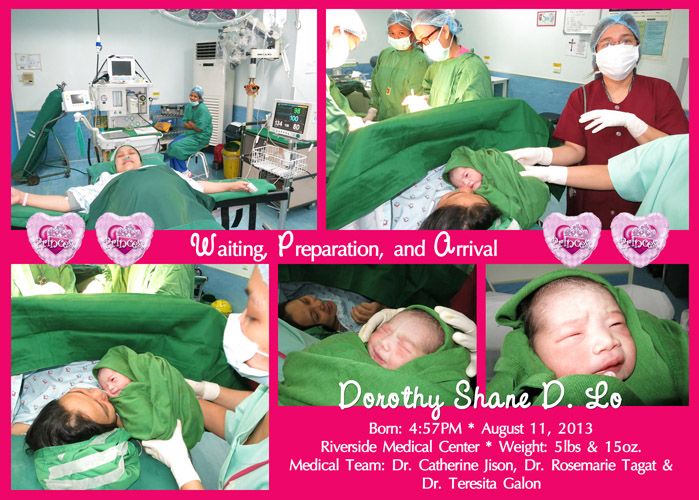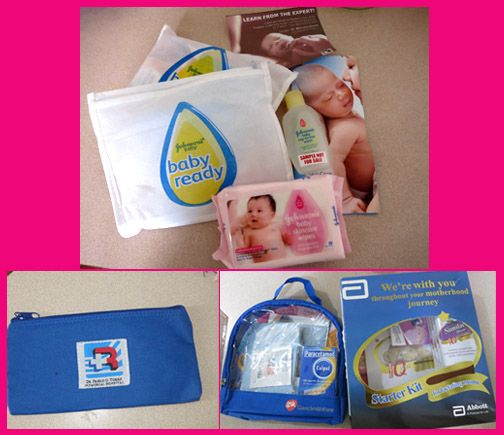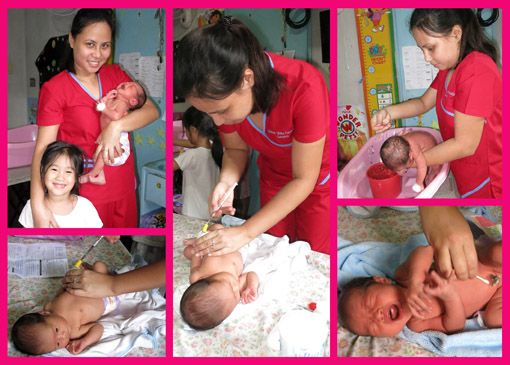
A photo collage of my delivery.
A few months before I was going to give birth, I inquired about the hospital rates so that we would know how much to prepare for my delivery. Then I learned that rooming-in with the infant is already mandatory all hospitals. During Dindin’s time, it was still optional, and I was taken aback.
Honestly, I wanted to cry at the set up. I had a difficult delivery with Dindin and the post-natal experience was not very encouraging. I gave birth at Riverside Medical Center and although they were already pushing for breastfeeding at that time, there was no support. The first time I got to the breastfeeding station, the nurse gave Dindin to me and left immediately, without helping me go about it. For a first time mom who just underwent a terrible delivery via C-Section and still had her dextrose and catheter attached, I almost dropped Dindin.
This is compulsory rooming-in is because of the The Rooming-In and Breastfeeding Act of 1992 or Republic Act 7600 and Executive Order 51 of the Republic of the Philippines. Here they are, as follows:
“a. EO 51 THE MILK CODE – protection and promotion of breastfeeding to ensure the safe and adequate nutrition of infants through regulation of marketing of infant foods and related products. (e.g. breast milk substitutes, infant formulas, feeding bottles, teats etc. )”
“b. RA 7600 THE ROOMING –IN and BREASTFEEDING ACT of 1992
-An act providing incentives to government and private health institutions promoting and practicing rooming-in and breast-feeding.
-Provision for human milk bank.
-Information, education and re-education drive
-Sanction and Regulation”

My room at the Riverside Medical Center. Here, waiting for my C-Section schedule.
So anyway, I had no choice but to accept it. I only prayed that everything will be fine and that my fears would be unfounded. This is already my second C-Section–a scheduled one–so I wasn’t so stressed, even though I chose to have baby delivered a week before our target date of August 19.

The entrance to the Mother-Baby Friendly Complex located at the 3rd Floor of the Riverside Medical Center.
Thankfully, the system at Riverside Medical Center has drastically changed. All childbirth cases, whether through normal delivery or C-Section, are housed in the Mother-Baby Friendly Complex of the hospital. So there are no medical or surgical cases there apart from childbirth.There were pretty stringent rules around here, which are posted at the entrance of the wing.
There are wards where two patients and their babies can room-in and there are private rooms where there is only one patient and the baby. I chose the private room because for the P3,000 difference, I valued the privacy and the safety of the baby because she was going to stay with me.

Some of the nurses that attended to baby and me. Nurse Josephine is pictured 2nd from left. Thank you very much for all your help!
There is a set of nurses assigned to a number of mothers and another set handling the babies. All of them are trained and adept at handling maternal cases. And all of them, except one, are helpful and friendly. They have to be extra helpful because only one watcher is allowed per patient and so extra help is really needed. And it helped that they were smiling because it did alleviate my mood, even though I was in pain.
What I also appreciated most was the breastfeeding advice that I got from their head nurse, Miss Josephine. You see, I was on IV pain medication for the first three days and I couldn’t get up without getting nauseated. Most times, I would really throw up. So it was hard for me to breastfeed baby or to pump milk. On the third day, I was on the bed and somehow my hand felt my breasts. They have shrunk, as if they are already going back to their original size. I almost panicked. What happened to the breast milk? Ain’t I supposed to have milk for my baby? I went outside to the nurses’ station and thankfully, it was Nurse Josephine who I got to talk to. She encouraged me, saying that no, it is not true that I could not breastfeed. I just gave birth and the production of breast milk can be stimulated. She said that I am capable of producing milk. She told me that she will counsel me that day and so she did.

Dr. Marxwynn Diente during the breast feeding lecture.
So she went into my room and she taught me how to stimulate milk production, such as proper latching, how to pump, what to eat, and the like. Then she invited me to a breastfeeding seminar that afternoon, which was being held at one of the conference rooms at the hospital. It was being hosted by breastfeeding advocate, Bacolod-based pediatrician Marxwynn Diente. I obliged because I was really willing to learn. It was a free seminar and all the new mothers in the hospital were brought to the conference room on wheel chairs so there was really no excuse. I truly appreciated it.
After that, I let my baby latch and then I used my new breast pump. True enough, I was able to produce about 5ml of milk on the first try. It was not much but my heart really jumped in elation upon seeing white droplets come out of my nipples. I had hope! Then I just continued it. Despite the pain, I was really very happy to be able to produce a little milk and I was armed with hope that maybe, with this baby, I can fully breastfeed her–something that I was not able to do with my eldest despite my strong desire to do so.  At that time, there were not resources such as these.
At that time, there were not resources such as these.
I still had difficulty positioning baby with my right breast and it was my OB-Gyne who helped me correct the situation.
Review of the Rooming-In System
After my experience, I am still for giving mothers a choice as to whether to room in with their babies or not after delivery. I know that many mothers appreciate this but for me, I would rather have rested on the first two days. After all, I was sedated and mostly nauseated so I didn’t handle my baby during this time. I was also very itchy all over because of the anesthetic used during my C-Section. And I got stressed because I also woke up every time baby cried and could not do anything about it. By the time I could already stand on my feet and be able to latch her, she was taken away from our room and moved to a treatment room for photo therapy because she has jaundice. She was only brought back to me every time she had to feed. So the rooming-in system did not work for me. That is why, I think that mothers should have a choice.

Cuddling and sleeping with baby are among the things you can do when you are roomed in together. Taken the day after I gave birth. I couldn’t stand without throwing up, so baby was just placed beside me.
Additionally, it cost us extra money because I got a private room. I was fine with the ward if it was not for the rooming-in setup. With Dindin, I stayed in the ward and that was okay. I just thought that there would be so many people in the room already with the baby and she is still so young. Her immunity is not yet built, so I thought that it was best to limit her human interaction–especially with people that we don’t know.
I appreciate this law about encouraging mothers to breastfeed and all. This program includes the Unang Yakap (first hug) practice where upon birth at the delivery room, the baby was placed on the mom’s tummy and was allowed to crawl up to find the breasts and latch. This was done on the first 30 minutes of birth. This was not done in my case because I was sedated after C-Section.

This baby has got a lot of free stuff, even before she was born. At the hospital, we were given bath starter kits from Johnsons, Similac starter kits for lactating moms, Calpol and Physiogel samples and a vanity kit from Riverside–a token for their anniversary.
Another thing about the new system is their after-discharge services. Shane needed to complete her antibiotics and when we were discharged, she still had three doses left. During Dindin’s time, we had to leave her at the hospital because our only choice was to bring her home and then bring her back to the hospital three times a day or hire a nurse that we know to do it. This time, the hospital offered the service. The fee was just P300/visit of the nurse and she was already responsible for giving the medication. And when she came during mornings, the visit included giving baths to the baby. Not bad, at least we would not have to go out anymore. So I really love this service!

After we were discharged, a nurse came over to administer Shane’s antibiotics intravenously. She also gave baby a bath, cleaned the ears, and the cut of the umbilical cord.
Anyway, after all is said and done, I am just thankful that my baby and I are both safe and okay now. And I just want to take this opportunity to thank my very nice doctors–Dr. Catherine Jison (OB-Gyne), Dr. Teresita Galon (anesthesiologist), and Dr. Rosemarie Tagat (pediatrician). And then of course, special thanks to all the nurses and auxiliaries who were very friendly, helpful, insightful, and encouraging. Thank you very much for making it a wonderful experience!
I am not sure if this is the same set up in other hospitals but what I know is that rooming-in is already in effect in all hospitals in the country.
My Husband’s Opinion
My husband says that he is for the compulsory rooming-in because, if you come to think of it, we can have a million reasons to give if we don’t want to room-in. Well, I have to agree with him, because while men do not endure the pains of childbirth, my husband is surely the type who would willingly go through with it just to spare me from the pain.
While there is already a lot of effort in encouraging breastfeeding among the new mothers, my husband feels that there is room for improvement. All doctors and nurses dealing with the patients can still be equipped some more in the area of breastfeeding so that they can impart more knowledge to the mothers. He thinks that it should become sort of a “passion” of medical professionals to motivate mothers to breastfeed, like in Australia, where breastfeeding is almost compulsory. We heard that the mother and child will not be released from the hospital if breastfeeding is not in place. Wow!
Hubby says that another reason he is in favor of the compulsory rooming-in is because it just makes it easier for the medical professionals to sort of “train” the mothers on how to properly breastfeed and be able to fully breastfeed their babies as much and as long as they can. He says that maybe mothers who delivered by C-Section can be allowed a two-day recuperation period and then the “training” on breastfeeding can start.